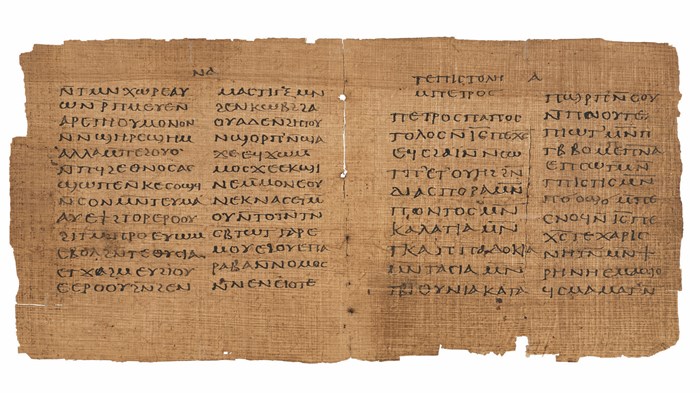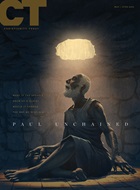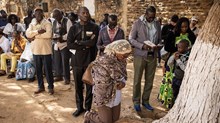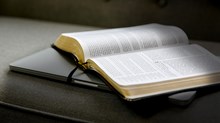
One of the oldest books in existence, which contains what is perhaps the oldest complete versions of Jonah and 1 Peter, is going up for auction in June. The sale of the Crosby-Schøyen Codex has scholars excited to talk about its uniqueness—and nervous about whether it could go into private hands and disappear.
The Crosby-Schøyen Codex is a primary example of the invention of books, which coincided with the spread of Christianity, said Eugenio Donadoni, a specialist in books and manuscripts at Christie’s London, which is auctioning the codex. The growth of Christianity spurred the need to “maximize the text you can write down and transmit … around the Mediterranean,” Donadoni said.
Before codices appeared in roughly the third century, scrolls “for several thousand years were the primary vehicle for transmitting literature,” said Brent Nongbri, an expert in early Christian manuscripts and a professor at the Norwegian School of Theology.
Codices were a technological advancement that “that wouldn’t be surpassed until the discovery of the printing press,” Donadoni added. Donadoni just finished touring the codex for potential buyers in New York and Paris before returning it to London, where it will be auctioned on June 11. About the codex he said, “I’ve never seen anything like this.”
A single scribe wrote out the texts of the codex on papyrus leaves in Sahidic Coptic somewhere between A.D. 250 and 350, according to carbon dating of the codex conducted in 2020. That means it’s likely the text was written before the fourth-century church councils and during the time of the great persecutions.
“This is being used at a time when Christians are still finding their feet,” said Donadoni.
The codex contains Jonah, 1 Peter, a passage from 2 Maccabees, a Passover text from second-century church leader Melito of Sardis, and an Easter sermon.
New Testament scholar David Horrell has argued that these different texts in the codex relate to each other in how they talk about suffering and resurrection, and may have been an Easter liturgy. Melito’s text on the Passover talks about Christ as the Passover lamb and uses parallel language to 1 Peter. Jonah, some scholars argue, was a major figure in early Christianity in Egypt and repeatedly appeared in Christian art there.
Horrell notes Jonah’s “perceived relevance as a type of the Easter story, a sign of resurrection, notably in the ‘three days and three nights’ Jonah spends inside the fish.” The Maccabees text, focused on martyrdom, goes along with that liturgical theme of the suffering of both Christ and God’s people.
“We can slip into thinking that there’s just the New Testament—this particular collection of books—and that’s what everybody was reading,” said Nongbri. “But when we get back into this early period, there's actually different collections circulating. And this one is an interesting group of texts and allows us to imagine, What would have this been used for? … What kind of liturgical use might this have had?”
The codex comes from the private collection of Norwegian Martin Schøyen, who has one of the largest collections of biblical texts. Some of the other largest biblical-text reserves are the Green Collection behind the Museum of the Bible and the British and Foreign Bible Society collection at Cambridge.
Museums and private collectors have had issues with ancient items’ provenance, like whether they were looted. The codex has a documented provenance and was a legal export out of Egypt, although the story of its original discovery is “open for debate,” said Nongbri. Yet Donadoni says there is “general consensus” that the codex was found near a particular monastic complex in Egypt.
The codex was buried in a jar in sand, according to the collector. An antiquities dealer first placed it on the market in the 1950s, and it eventually went to the University of Mississippi in 1955, which had a large archaeology department at the time. The university sold it in 1981, and then it passed to private collectors.
If the codex was from the earlier end of its carbon dating between 250 and 350, that would make it the oldest book, including the oldest copies of 1 Peter and Jonah. William Willis, an early scholar studying the codex, argued that “it may be dated with some confidence to the middle of the third century,” or 250.
But if it was produced at a monastery, then it likely came at the later end of the carbon-dating window, according to Nongbri, because monasteries took off in the fourth century.
Other scholars have argued that it could have been produced earlier and stored at the monastery where it was later discovered. Horrell, for one, argued the codex was produced before the monastery was founded.
Is it the oldest book in existence?
“It could be,” said Nongbri. “But it's not certain.”
In the codex, the 1 Peter text is described as “the letter of Peter” and does not make any reference to 2 Peter. The Schøyen Collection says that means it was copied in A.D. 60–130, making it the “single most important [manuscript] of 1 Peter.”
Christie’s estimates the codex will sell for $2.5 to $3.75 million. Last year the Codex Sassoon, considered the oldest near-complete Hebrew Bible, broke records for the sale of a book or historical document when it sold at auction for $38.1 million.
Scholars worry about where the codex will end up.
“There’s always the fear when something goes up for sale … it could go behind doors that would make it hard for researchers to access it,” said Jordan Jones, an expert in biblical texts and archaeology at the University of Iowa.
Nongbri concurred: “We just worry about it disappearing.”
Nongbri and Donadoni both noted that the Schøyen Collection allowed scholars in to study the codex, with the carbon-dating study as the most recent example. The Schøyen Collection had photographed the codex, and Christie’s also photographed and digitized it.
But there is more research to conduct on it with newer imaging tools. Jones noted how multispectral imaging, for example, helped researchers see words no one had seen on the Dead Sea Scrolls. That hasn’t been done on the codex, he said.
“Researchers would have a field day [with the codex] if they got a chance,” Jones said. “These pages are in a better state of legibility than the Dead Sea Scrolls.”
Multispectral imaging could show any changes made to the text, such as whether there was initially a different word under the visible word, Jones explained. He also said there could be more studies on the way the codex was bound.
“There's definitely more to look at from a sort of book history standpoint,” said Nongbri. “Certainly multispectral imaging would be great.”
Donadoni from Christie’s London said he is hoping an institution steps in to buy the codex. The auction will include other biblical texts: the Holkham Hebrew Bible, the Codex Sinaiticus Rescriptus, and the Geraardsbergen Bible. In the Codex Sinaiticus Rescriptus, the Gospels were written in fifth-century Christian Palestinian Aramaic that was largely erased and written over by a tenth-century Georgian Palestinian monk.
Scholars of these texts will be watching the auction on June 11—and hope that they might know who the buyer is afterward. Sometimes buyers are not disclosed.
Nongbri said any major university that has a papyrus collection has the proper conditions for storing the codex, the personnel to care for it, and the systems for academics to study it.
“That’s the ideal setting for something like this,” he said.
This article has been updated to clarify that the fourth century church councils were not establishing biblical canon.

Support Our Work
Subscribe to CT for less than $4.25/month


















